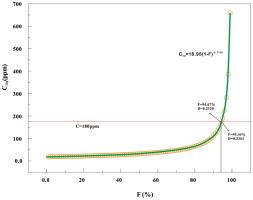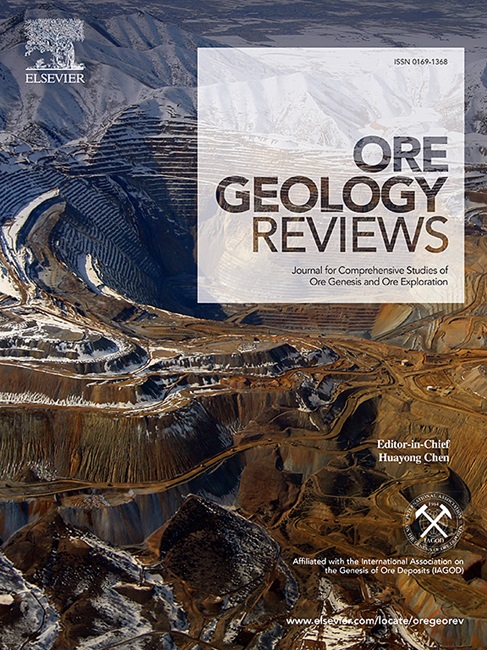Crystallographic insights and crystal fractionation simulations of alkali- and water-bearing beryl: Implications for magmatic–hydrothermal evolution and Be enrichment mechanisms
IF 3.6
2区 地球科学
Q1 GEOLOGY
引用次数: 0
Abstract
Beryl, an economically significant mineral containing high concentrations of the critical metal Be, has been the subject of considerable characterization regarding its crystal structure and chemical composition. Despite this, discerning between alkali- and H2O-bearing beryls solely based on the alkali and water contents within the structural channels of beryl has remained a challenge. Additionally, the mechanisms that cause granitic melts to become enriched in Be remain ambiguous. Through comprehensive chemical and structural analyses of representative alkali-water-bearing beryl samples from Igla of East Egypt and Baishawo of South China, this contribution improves the beryl classification model and provides new perspectives on Be enrichment mechanisms. This analysis has demonstrated that a linear correlation exists between the water content and alkali content of hydrous beryls, and identified two distinct types of H2O molecules — Type I and II. Major elements are uniformly distributed throughout beryl grains, whereas trace elements exhibit core–rim zonation. Crystal–chemical characteristics of alkali- and water-bearing beryls provide valuable insights into pegmatite evolution, with implications for understanding mineralizing processes and formation conditions. The distributions of alkali metals, Mg, Mn and Fe in alkali-rich and H2O-rich (ARHR) beryl suggest that the pegmatite in the beryl-bearing zones is the product of magmatic metls. Low Fe/Mg ratios of alkali-poor and H2O-rich (APHR) beryl are associated with hydrothermal alkali-metasomatism. Using the Baishawo Be–Li–Nb–Ta pegmatite deposit as a case study, we utilize crystal fractionation simulations to demonstrate the alkali- and water-bearing beryls crystallized after high degrees of magma evolution. The study contributes to the classification of beryl varieties based on chemistry and structure, and provides new insights into Be enrichment mechanism in granitic melts and hydrothermal fluids.

含碱和含水绿柱石的晶体学见解和晶体分馏模拟:对岩浆-热液演化和 Be 富集机制的影响
绿柱石是一种具有重要经济价值的矿物,含有高浓度的临界金属 Be,人们对其晶体结构和化学成分进行了大量研究。尽管如此,仅仅根据绿柱石结构通道中的碱和水含量来区分含碱和含水的绿柱石仍然是一项挑战。此外,导致花岗岩熔体富含Be的机制仍然模糊不清。通过对埃及东部伊格拉和中国南部白沙窝具有代表性的含碱含水绿柱石样品进行全面的化学和结构分析,本文改进了绿柱石分类模型,并为 Be 富集机制提供了新的视角。分析表明,含水绿柱石的含水量和含碱量之间存在线性相关关系,并确定了两种不同类型的 H2O 分子--I 型和 II 型。主要元素在整个绿柱石晶粒中均匀分布,而微量元素则呈现核心-边缘带状分布。含碱和含水绿柱石的晶体化学特征为伟晶岩演化提供了宝贵的见解,对了解成矿过程和形成条件具有重要意义。富碱和富含水(ARHR)绿柱石中碱金属、镁、锰和铁的分布表明,含绿柱石区的伟晶岩是岩浆金属的产物。贫碱和富含 H2O(APHR)绿柱石的低铁/镁比率与热液碱熔岩作用有关。以白沙窝铍铌钽伟晶岩矿床为例,我们利用晶体分馏模拟来证明含碱和含水绿柱石是在岩浆高度演化后结晶的。该研究有助于根据化学和结构对绿柱石品种进行分类,并为花岗岩熔体和热液中的铍富集机制提供了新的见解。
本文章由计算机程序翻译,如有差异,请以英文原文为准。
求助全文
约1分钟内获得全文
求助全文
来源期刊

Ore Geology Reviews
地学-地质学
CiteScore
6.50
自引率
27.30%
发文量
546
审稿时长
22.9 weeks
期刊介绍:
Ore Geology Reviews aims to familiarize all earth scientists with recent advances in a number of interconnected disciplines related to the study of, and search for, ore deposits. The reviews range from brief to longer contributions, but the journal preferentially publishes manuscripts that fill the niche between the commonly shorter journal articles and the comprehensive book coverages, and thus has a special appeal to many authors and readers.
 求助内容:
求助内容: 应助结果提醒方式:
应助结果提醒方式:


